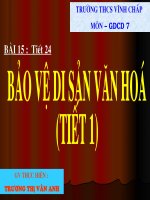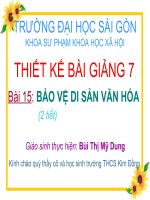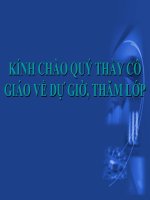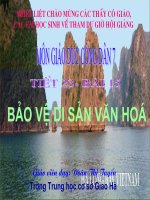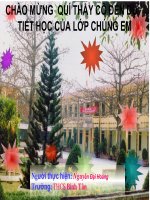Sổ tay hướng dẫn bảo vệ di sản văn hóa Tập 3 Tư liệu hóa sưu tập hiện vật bảo tàng
Bạn đang xem bản rút gọn của tài liệu. Xem và tải ngay bản đầy đủ của tài liệu tại đây (756.67 KB, 38 trang )
BOOK 3 Document.qxp
1/25/08
6:22 PM
Page 1
S‡ TAY H¶õNG D√N BÅO Vå DI SÅN V°N HïA
T¶ LIåU HïA S¶U TÜP
HIåN VÜT BÅO TÄNG
DOCUMENTATION OF
ARTEFACTS' COLLECTIONS
3
BOOK 3 Document.qxp
1/25/08
6:22 PM
Page 2
C∏c c¨ quan vμ c∏ nh©n c„ th” t∏i b∂n tμi li÷u nμy, vÌi Æi“u ki÷n ghi r‚ nguÂn,
vμ gˆi xu†t b∂n ph»m Æ’n UNESCO Paris theo Æfia chÿ d≠Ìi Æ©y. Tμi li÷u nμy c«n
ghi r‚:
© B∂n quy“n phi™n b∂n ti’ng Anh: UNESCO, 2007. SÊ tay h≠Ìng d…n b∂o v÷ di
s∂n v®n h„a - TÀp 3. T≠ li÷u h„a s≠u tÀp hi÷n vÀt b∂o tμng, UNESCO Paris.
© B∂n quy“n phi™n b∂n ti’ng Vi÷t: UNESCO vμ CÙc Di s∂n v®n h„a - BÈ V®n h„a,
Th” thao vμ Du lfich, 2008.
Xu†t b∂n bªng ti’ng Vi÷t vÌi s˘ ÆÂng ˝ cÒa UNESCO.
Chfiu tr∏ch nhi÷m b∂n dfich: CÙc Di s∂n v®n h„a - BÈ V®n h„a, Th” thao vμ Du
lfich vμ V®n phflng UNESCO Hμ NÈi.
Reproduction is authorized, providing that appropriate mention is made of the
source, and a copy sent to the UNESCO (Paris), address below. This document
should be cited as:
© UNESCO, 2007. Cultural Heritage Protection Handbook No3. Documentation
of Artefacts’ Collections, UNESCO, Paris.
© UNESCO & the Department of Cultural Heritage - Ministry of Culture, Sports
and Tourism of Vietnam 2008 for the Vietnamese translation.
Reproduced by permission of UNESCO.
Chfiu tr∏ch nhi÷m bi™n tÀp / Editor: Anna Paolini
Bi™n tÀp vi™n / Editorial assitants: Malda Jabbour, Lise Macdonald
NÈi dung / Text by: Matthew Stiff
H‰a s¸ / Drawings by: Beatrice Beccaro Migliorati
TÊ ch¯c Gi∏o dÙc, Khoa h‰c vμ V®n h„a cÒa Li™n hi÷p quËc xu†t b∂n l«n Æ«u n®m 2007
Printed in 2007 by the: United Nations Educational, Scientific and Cultural Organization
7, place de Fontenoy, 75732 Paris 07 SP, France
© UNESCO 2007
(CLT/CH/MUS-06/19)
BOOK 3 Document.qxp
1/25/08
6:22 PM
Page 1
GIõI THIåU
CuËn s∏ch nμy Æ≠Óc xu†t b∂n dμnh cho t†t c∂ nh˜ng ai s≠u t«m vμ
y™u qu˝ hi÷n vÀt c„ gi∏ trfi v“ mΔt x∑ hÈi, m¸ thuÀt vμ/hoΔc lfich sˆ,
vμ dμnh cho nh˜ng ng≠Íi phÙ tr∏ch s≠u tÀp hi÷n vÀt t≠ nh©n vμ
nhμ n≠Ìc.
Tr‰ng t©m cÒa cuËn s∏ch nμy lμ nh˜ng nguy™n tæc v“ t≠ li÷u h„a.
MÈt sË h≠Ìng d…n trong cuËn s∏ch nμy Æ≠Óc x©y d˘ng dμnh ri™ng
cho c∏c th” ch’ Æ≠Óc trang bfi thi’t bfi vμ nh©n vi™n ch¯ kh´ng dμnh
cho c∏c c∏ nh©n. Song, nh˜ng khuy’n nghfi nμy bao gÂm c∏c bμi
h‰c kinh nghi÷m Î c∏c m¯c ÆÈ kh∏c nhau mμ nhμ s≠u tÀp c«n nÁ
l˘c Æ” th˘c hi÷n Æ≠Óc cμng nhi“u cμng tËt.
INTRODUCTION
This booklet is intended for all who collect and are fond of items
of social, artistic and/or historical significance, as well as those in
charge of public or private collections of such items.
This booklet focuses on principles of documentation. Certain
measures are directed towards institutions with equipment and
personnel not within the means of private individuals. However,
these recommendations embody levels of best practice which one
should endeavor to reach as far as possible.
UNESCO
1
BOOK 3 Document.qxp
1/25/08
6:22 PM
Page 2
Tπi sao c´ng vi÷c t≠ li÷u h„a lμ quan tr‰ng?
WHY DOCUMENTATION IS IMPORTANT
T≠ li÷u h„a lμ qu∏ tr◊nh ghi lπi nh˜ng th´ng
tin v“ s≠u tÀp hi÷n vÀt mμ b∂o tμng hoΔc
mÈt thi’t ch’ v®n h„a chfiu tr∏ch nhi÷m.
Documentation is the process of recording
information about the collections for which
a museum or cultural institution is responsible.
Th˘c hi÷n ÆÛng c´ng t∏c t≠ li÷u h„a sœ cho phäp
b∂o tμng:
● Bi’t Æ≠Óc m◊nh sÎ h˜u nh˜ng g◊
● Bi’t Æ≠Óc m◊nh thi’u nh˜ng g◊
● Bi’t Æ≠Óc vfi tr› cÒa c∏c hi÷n vÀt
● Ch¯ng minh Æ≠Óc quy“n sÎ h˜u ÆËi vÌi c∏c
hi÷n vÀt
● Tπo ra vμ duy tr◊ th´ng tin v“ c∏c bÈ s≠u tÀp
hi÷n vÀt
Proper documentation will allow a museum to:
● Know what it has in its possession
● Know if anything is missing
● Know where objects are located
● Prove ownership of objects
● Create and maintain information about
collections
2
UNESCO
BOOK 3 Document.qxp
1/25/08
6:22 PM
Page 3
Ti™u chu»n ÆËi vÌi t≠ li÷u h„a
DOCUMENTATION STANDARDS
Hi÷n vÀt ph∂i Æ≠Óc t≠ li÷u h„a mÈt c∏ch nh†t
qu∏n d˘a theo nh˜ng ti™u chu»n nh†t Æfinh.
C∏c ti™u chu»n nμy Æ∑ Æ≠Óc c∏c tÊ ch¯c trong
n≠Ìc vμ quËc t’ x©y d˘ng bao gÂm ICOM vμ
UNESCO. C∏c ti™u chu»n nμy sœ giÛp bπn
th˘c hi÷n c´ng t∏c t≠ li÷u h„a.
Objects should be documented consistently
using recognised standards. These have
been developed by national and international
organisations, including ICOM and UNESCO,
and will help you.
Ti™u chu»n h„a c†u trÛc h s¨ hi÷n vÀt vμ
c∏c thuÀt ng˜ Æ” Æ∂m b∂o:
● ßÈ tin cÀy cÒa th´ng tin
● D‘ dμng chia sŒ
● T›nh ÆÂng bÈ cÒa h s¨ hi÷n vÀt
● M¯c ÆÈ ti’p cÀn
Standardising the structure of records and
the terminology helps to ensure :
● Reliability of information
● Ease of sharing
● Consistency of records
● Improved access
UNESCO
3
BOOK 3 Document.qxp
1/25/08
6:22 PM
Page 4
M´ t∂ vμ lÀp danh mÙc hi÷n vÀt
DESCRIBING AND CATALOGUING OBJECTS
M´ t∂ chi ti’t vμ ch›nh x∏c v“ hi÷n vÀt lμ mÈt
vi÷c lμm c«n thi’t Æ” Æ“ phflng tr≠Íng hÓp
hi÷n vÀt bfi th†t lπc hoΔc m†t trÈm.
Vi÷c lμm nμy cÚng giÛp bπn nhÀn ra hi÷n vÀt
vμ ph©n bi÷t n„ vÌi nhi“u hi÷n vÀt t≠¨ng t˘.
It is a good idea to have an accurate and
detailed description of your object in case it
is lost or stolen.
It will also help you to recognise it and distinguish it from other similar objects if
found.
Object ID (Ph«n m“m qu∂n l˝ th´ng tin
hi÷n vÀt)
Nh˜ng h≠Ìng d…n sau Æ©y Æ≠Óc Æ≠a ra d˘a
tr™n h÷ ti™u chu»n Æ∑ Æ≠Óc quËc t’ c´ng
nhÀn lμ Object ID.
Object ID
The following guidelines are based on an
internationally-recognised standard called
Object ID.
4
UNESCO
BOOK 3 Document.qxp
1/25/08
6:22 PM
Page 5
M´ t∂ vμ lÀp danh mÙc hi÷n vÀt
DESCRIBING AND CATALOGUING OBJECTS
Ph©n loπi hi÷n vÀt
Bπn c«n ghi lπi loπi hi÷n vÀt Æang m´ t∂.
Th› dÙ, hi÷n vÀt lμ:
● t≠Óng?
● l‰?
● tranh vœ?
● th≠ tfich?
● mÈt m„n ÆÂ trang s¯c (vflng cÊ, tr©m cμi t„c, v.v.)?
Object Type
You will need to record the type of object you are
describing. For example, is it a:
● sculpture?
● vase?
● painting?
● manuscript?
● item of jewellery (necklace, brooch etc.)?
Ch†t li÷u
Hi÷n vÀt Æ≠Óc ch’ t∏c tı nh˜ng vÀt li÷u g◊?
● Æ∏?
● gËm?
● ÆÂng?
● gÁ, v.v.?
Material
What materials is the object made from?
Is it :
● stone?
● ceramic?
● bronze?
● wood etc.?
UNESCO
5
BOOK 3 Document.qxp
1/25/08
6:22 PM
Page 6
M´ t∂ vμ lÀp danh mÙc hi÷n vÀt
DESCRIBING AND CATALOGUING OBJECTS
K¸ thuÀt
Hi÷n vÀt Æ≠Óc ch’ t∏c bªng nh˜ng k¸ thuÀt g◊?
● chπm khæc?
● ÆÛc?
● vœ?
● in, v.v.?
Technique
What techniques were used in the production
of this object? Was it :
● carved?
● cast?
● painted?
● printed etc.?
K›ch th≠Ìc
C∏c sË Æo vμ ƨn vfi Æo cÒa hi÷n vÀt? H∑y th™m vμo c∏c
th´ng tin sau n’u phÔ hÓp:
● chi“u cao
● chi“u rÈng
● ÆÈ s©u
● Æ≠Íng k›nh
Bπn cÚng c„ th” ghi lπi th´ng tin v“ tr‰ng l≠Óng cÒa
hi÷n vÀt.
Dimensions
What are the measurements and units of measurement
of the object? Include as appropriate :
● height
● width
● depth
● diameter
You may also want to include the weight of the object.
6
UNESCO
BOOK 3 Document.qxp
1/25/08
6:22 PM
Page 7
M´ t∂ vμ lÀp danh mÙc hi÷n vÀt
DESCRIBING AND CATALOGUING OBJECTS
Th´ng tin Æ∏nh d†u hi÷n vÀt
Hi÷n vÀt c„ nh˜ng d†u hi÷u d‘ nhÀn bi’t hoΔc dflng Æ“
tΔng nμo kh´ng? C∏c d†u hi÷u nμy c„ th” lμ:
● d†u hi÷u ri™ng hoΔc d†u cÒa t∏c gi∂
● ch˜ in hoΔc khæc
● ch˜ k˝
● d†u v’t thˆ h„a ch†t
● sË k˝ hi÷u (th› dÙ m∑ nhÀp hi÷n vÀt)
Inscriptions and Markings
Does the object have any clearly identifiable marks or
inscriptions? These could include:
● maker’s mark or stamp
● printed or inscribed text
● signatures
● assay marks
● identification numbers (e.g. a museum accession
number)
Nh˜ng ÆΔc Æi”m ri™ng bi÷t
Hi÷n vÀt cÒa bπn cfln c„ nh˜ng ÆΔc Æi”m ri™ng
nμo kh∏c giÛp nhÀn di÷n kh´ng? C∏c ÆΔc Æi”m
nμy c„ th” lμ:
● nh˜ng chÁ h≠ h·ng
● nh˜ng chÁ sˆa ch˜a
● nh˜ng chÁ Æi“u chÿnh
● nh˜ng khi’m khuy’t trong qu∏ tr◊nh s∂n xu†t
Distinguishing Features
Are there other features about your object that
could help to identify it? These could include :
● damages
● repairs
● modifications
● manufacturing defects
UNESCO
7
BOOK 3 Document.qxp
1/25/08
6:22 PM
Page 8
M´ t∂ vμ lÀp danh mÙc hi÷n vÀt
DESCRIBING AND CATALOGUING OBJECTS
T˘a Æ“
Hi÷n vÀt cÒa bπn c„ t˘a Æ“ g◊ kh´ng? T˘a Æ“
th≠Íng Æ≠Óc dÔng Æ” ÆΔt t™n cho c∏c t∏c
ph»m ngh÷ thuÀt vμ thuÀn lÓi khi nhÀn di÷n
hi÷n vÀt trong tr≠Íng hÓp bfi th†t lπc hoΔc
m†t cæp.
Title
Does your object have a title? This is often
true of artworks and may help in the identification of your object if lost or stolen.
ChÒ Æ“
Khi hi÷n vÀt lμ t∏c ph»m ngh÷ thuÀt, ghi r‚
hi÷n vÀt Æ„ m´ t∂ hoΔc giÌi thi÷u v“ c∏i g◊?
Th› dÙ:
● c∏c kim t˘ th∏p Î Giza
● mã vμ con
● phong c∂nh nÛi non, v.v.
Subject
If your object is an artwork, what does it
depict or represent? Examples could
include:
● the pyramids at Giza
● mother and child
● landscape with mountains etc.
8
UNESCO
BOOK 3 Document.qxp
1/25/08
6:22 PM
Page 9
M´ t∂ vμ lÀp danh mÙc hi÷n vÀt
DESCRIBING AND CATALOGUING OBJECTS
Ni™n Æπi hoΔc thÍi k˙
Hi÷n vÀt c„ ni÷n Æπi tı khi nμo?
Hi÷n vÀt Æ≠Óc ch’ t∏c vμo thÍi gian nμo?
Date or Period
When does the object date from?
When was it made?
Ng≠Íi ch’ t∏c
Ai lμ ng≠Íi ch’ t∏c ra hi÷n vÀt? Ng≠Íi nμy c„ th”
lμ:
● c∏ nh©n (h‰a s¸, nhμ Æi™u khæc, ng≠Íi lμm ÆÂ
gÁ, v.v.)
● c´ng ty
● mÈt cÈng ÆÂng v®n h„a (ÆΔc bi÷t c„ ˝ ngh‹a
khi m´ t∂ cÊ vÀt)
Maker
Who was the object made by? This could be:
● an individual (painter, sculptor, furniture
maker etc.)
● a company
● a cultural group (particularly useful for
describing ancient artefacts)
UNESCO
9
BOOK 3 Document.qxp
1/25/08
6:22 PM
Page 10
M´ t∂ vμ lÀp danh mÙc hi÷n vÀt
DESCRIBING AND CATALOGUING OBJECTS
M´ t∂ s¨ l≠Óc
Vi’t mÈt Æoπn m´ t∂ s¨ l≠Óc v“ hi÷n vÀt,
trong Æ„ gÂm b†t k˙ th´ng tin nμo kh∏c c„
th” giÛp nhÀn di÷n hi÷n vÀt. Nh˜ng th´ng tin
nμy c„ th” lμ:
● mμu sæc
● h◊nh d∏ng
● n¨i ch’ t∏c (n’u bi’t)
Short Description
Write a short description of the object
including any other information that will
help to identify the object. This could
include :
● colour
● shape
● where the object was made (if known)
C∏c th´ng tin kh∏c
N’u hi÷n vÀt gÂm c„ nhi“u ph«n kh∏c nhau
(th› dÙ: mÈt bÈ ÆÂ gÁ), n™n m´ t∂ tıng ph«n
ri™ng bi÷t.
Bπn cÚng c„ th” chÙp ∂nh hi÷n vÀt vμ ghi lπi
t†t c∂ c∏c th´ng tin v“ y™u c«u l≠u tr˜
Additional Points
If your object consists of more than one
part (e.g. a set of furniture), you may need
to describe each part separately.
You may also want to photograph your
object and record information about its
storage requirements.
10
UNESCO
BOOK 3 Document.qxp
1/25/08
6:22 PM
Page 11
ChÙp ∂nh hi÷n vÀt
PHOTOGRAPHING OBJECTS
Vi÷c chÙp ∂nh hi÷n vÀt giÛp nhÀn di÷n hi÷n
vÀt trong tr≠Íng hÓp bfi th†t lπc hoΔc m†t
trÈm.
C∏c b¯c ∂nh chÙp cÚng c„ th” gi∂m thi”u
nhu c«u c«m næm c∏c hi÷n vÀt d‘ vÏ, giÛp
phflng tr∏nh nh˜ng h≠ hπi kh´ng c«n thi’t.
Photographing your object will help in identification if it is lost or stolen.
Photographs can also reduce the need to
handle fragile objects, preventing unnecessary damage.
K›ch th≠Ìc vμ mμu sæc
N™n kÃm mÈt th≠Ìc Æo vμo ∂nh chÙp Æ” giÛp
nhÀn bi’t Æ≠Óc ÆÈ lÌn cÒa hi÷n vÀt. MÈt c©y
th≠Ìc kŒ cÚng c„ th” mang lπi hi÷u qu∂.
N’u Æ≠Óc, c„ th” kÃm b∂ng mμu vμo ∂nh chÙp.
Nh≠ vÀy sœ cho phäp x∏c Æfinh ÆÛng c∏c mμu sæc.
ßËi vÌi ∂nh træng Æen, h∑y sˆ dÙng b∂ng mμu
s∏ng tËi Æ” c„ th” x∏c Æfinh Æ≠Óc ÆÛng gam mμu
cÒa hi÷n vÀt.
Size and Colour
It is a good idea to include a scale in your photograph to show how large the object is. A ruler
will do. If possible, include a colour chart. This
will allow colours to be properly determined.
Black and white photographs can use a grey
scale to allow the correct tones to be determined.
UNESCO
11
BOOK 3 Document.qxp
1/25/08
6:22 PM
Page 12
ChÙp ∂nh hi÷n vÀt
PHOTOGRAPHING OBJECTS
SË k˝ hi÷u
N’u hi÷n vÀt c„ mÈt sË k˝ hi÷u ÆΔc bi÷t Æ”
nhÀn di÷n (th› dÙ: m∑ nhÀp hi÷n vÀt), n™n
Æ›nh kÃm m∑ sË vμo ∂nh.
Identity Numbers
If the object has a unique number by which
it can be identified (e.g. a museum accession number) it is a good idea to include this
in the photograph.
Chi’u s∏ng hi÷n vÀt khi chÙp ∂nh
H∑y sˆ dÙng l≠Óng ∏nh s∏ng ÆÛng y™u c«u
khi chÙp ∂nh hi÷n vÀt. H∑y tham v†n nhμ
nhi’p ∂nh c„ kinh nghi÷m.
Lighting Objects
Try to use the right kind of lighting for the
object you are photographing. It is worth
getting advice from an experienced photographer.
12
UNESCO
BOOK 3 Document.qxp
1/25/08
6:22 PM
Page 13
ChÙp ∂nh hi÷n vÀt
PHOTOGRAPHING OBJECTS
Ph´ng chÙp ÆÛng quy c∏ch
Hi÷n vÀt Æ≠Óc chÙp Î Æi“u ki÷n tËt nh†t vÌi
ph´ng tr¨n mμu træng. Vi÷c nμy b∂o Æ∂m s˘
c©n ÆËi v“ mμu sæc.
Ph´ng s…m mμu chÿ n™n dÔng n’u c«n tπo
s˘ t≠¨ng ph∂n.
Choosing the Right Background
Objects are best photographed against a
plain white backdrop. This is particularly
helpful in ensuring the correct colour balance is achieved.
Darker backgrounds should be used if it is
necessary to provide contrast.
ChÙp ∂nh c∏c hi÷n vÀt hai chi“u
C∏c hi÷n vÀt nh≠ tranh vœ, b∂n in, h‰a ti’t vμ ÆÂ
v∂i n™n chÙp tı tr™n xuËng. N’u Æ≠Óc, h∑y l†y c∏c
b¯c tranh treo tr™n t≠Íng xuËng, ÆΔt chÛng nªm
tr™n mÈt mΔt phºng vμ chÙp tı tr™n xuËng.
Trong tr≠Íng hÓp c«n thi’t, h∑y chÙp mΔt sau
cÒa hi÷n vÀt Æ” ghi lπi nh˜ng d†u hi÷u ÆΔc bi÷t
cÒa hi÷n vÀt
Photographing Two-dimensional Objects
Objects such as paintings, prints, drawings and
textiles are best photographed head on. Where
possible, remove pictures from walls, laying
them flat and photographing from above.
If necessary, photograph the reverse side of the
object to show any distinctive markings or features.
UNESCO
13
BOOK 3 Document.qxp
1/25/08
6:22 PM
Page 14
ChÙp ∂nh hi÷n vÀt
PHOTOGRAPHING OBJECTS
ChÙp ∂nh hi÷n vÀt c„ mΔt bªng chπm,
ÆÛc vμ chπm nÊi
C∏ch tËt nh†t Æ” chÙp ∂nh hi÷n vÀt loπi nμy
cÚng lμ tr˘c di÷n tı tr™n xuËng, t≠¨ng t˘ nh≠
tranh vœ hoΔc b∂n in, nh≠ng cÚng n™n chÙp
th™m c∏c ∂nh Î g„c chÙp kh∏c Æ” ghi lπi
chi“u cao hay ÆÈ s©u cÒa hi÷n vÀt.
Photographing Carved or Cast
Surfaces and Reliefs
Although these are best photographed head
on, like paintings or prints, it is also a good
idea to take other pictures from angles to
record the depth of the object.
ChÙp ∂nh c∏c hi÷n vÀt ba chi“u
H∑y cË gæng chuy”n t∂i Æ≠Óc h◊nh d∏ng tÊng
th” cÒa hi÷n vÀt. ß” th˘c hi÷n vi÷c nμy, bπn
n™n chÙp tı tr™n xuËng, Æ” th†y Æ≠Óc hi÷n
vÀt tı ph›a tr™n, ph›a tr≠Ìc vμ mΔt b™n. Bπn
cÚng c„ th” chÙp th™m nhi“u ∂nh kh∏c Æ”
th†y Æ≠Óc c∏c ph«n khu†t cÒa hi÷n vÀt.
Photographing Three-dimensional
Objects
Try to convey the overall shape of the object.
To do this, photograph it from above, showing the top, front and one side. You can take
more photographs to show any parts of the
object not visible.
14
UNESCO
BOOK 3 Document.qxp
1/25/08
6:22 PM
Page 15
ChÙp ∂nh hi÷n vÀt
PHOTOGRAPHING OBJECTS
ChÙp ∂nh c∏c chÁ h≠ h·ng vμ ÆΔc Æi”m
nÊi bÀt
CÔng vÌi vi÷c ghi lπi m´ t∂ s¨ l≠Óc, cÚng n™n
chÙp lπi b†t k˙ chÁ khi’m khuy’t hoΔc
nh˜ng ÆΔc Æi”m nÊi bÀt kh∏c Æ” c„ th” giÛp
nhÀn di÷n hi÷n vÀt.
Photographing Damage and
Distinguishing Features
As with written descriptions, it is a good
idea to photograph any distinguishing blemishes or features that will help to identify the
object.
Qu∂n l˝ quy“n sÎ h˜u tr› tu÷
MANAGING INTELLECTUAL PROPERTY RIGHTS
Quy“n sÎ h˜u vμ Quy“n sÎ h˜u tr› tu÷
LuÀt v“ qu∂n l˝ c∏c quy“n lÓi Î tıng quËc gia
c„ s˘ kh∏c nhau vμ c„ th” bao qu∏t nhi“u l‹nh
v˘c kh∏c ngoμi quy“n sÎ h˜u. Cho dÔ c„ th”
bπn Æang sÎ h˜u mÈt b¯c tranh hoΔc mÈt b¯c
t≠Óng, nh≠ng bπn c„ th” kh´ng næm gi˜
quy“n sÎ h˜u tr› tu÷ ÆËi vÌi hi÷n vÀt nμy.
Ownership and Intellectual Property Rights
Law on rights management will vary from
country to country and cover more than just
ownership. Although you may own a painting
or sculpture, you do not necessarily own the
intellectual property rights to it.
UNESCO
15
BOOK 3 Document.qxp
1/25/08
6:22 PM
Page 16
Qu∂n l˝ quy“n sÎ h˜u tr› tu÷
MANAGING INTELLECTUAL PROPERTY RIGHTS
Thi’t lÀp c∏c quy“n
X∏c Æfinh ai c„ quy“n t∏i s∂n xu†t mÈt hi÷n
vÀt hoΔc mÈt h◊nh ∂nh lμ r†t quan tr‰ng
trong tr≠Íng hÓp n’u sau nμy muËn t∏i s∂n
xu†t hi÷n vÀt nμy. Vi÷c nμy c«n ph∂i Æ≠Óc t≠
li÷u h„a mÈt c∏ch c»n thÀn.
Establishing Rights
It is important to establish who owns the
reproduction rights to an object or image in
case you want to reproduce it in the future.
This should be carefully documented.
B∑i b· c∏c quy“n
Trong h«u h’t c∏c tr≠Íng hÓp, c∏c b¯c ∂nh do
c∏n bÈ cÒa b∂o tμng chÙp sœ thuÈc v“ b∂o tμng.
Tuy nhi™n, n’u bπn sˆ dÙng mÈt nhμ nhi’p ∂nh
t˘ do, bπn sœ kh´ng sÎ h˜u c∏c quy“n ÆËi vÌi
nh˜ng b¯c ∂nh nμy. Trong tr≠Íng hÓp c«n thi’t,
h∑y Æ“ nghfi nhμ nhi’p ∂nh k˝ vμo ƨn x∏c nhÀn
tı b· c∏c quy“n nμy cÒa h‰.
Waiving Rights
In most cases, photographs taken by an employee of a museum will belong to the museum.
However, if you use a freelance photographer
you will not necessarily own the rights to the
images. If necessary, get the photographer to
sign a form waiving their rights.
16
UNESCO
BOOK 3 Document.qxp
1/25/08
6:22 PM
Page 17
C¨ sÎ d˜ li÷u tr™n m∏y t›nh
COMPUTERISED DATABASES
Ngμy cμng c„ nhi“u b∂o tμng vμ c∏c nhμ s≠u
tÀp t≠ nh©n l≠u tr˜ th´ng tin v“ hi÷n vÀt cÒa
m◊nh bªng vi÷c sˆ dÙng c¨ sÎ d˜ li÷u tr™n
m∏y t›nh.
C„ nhi“u c´ng ty cung c†p c∏c ph«n m“m
qu∂n l˝ s≠u tÀp hi÷n vÀt, vμ ÆÂng thÍi cÚng
c„ c∏c ¯ng dÙng ƨn gi∂n mi‘n ph›.
Increasingly museums and private collectors record information about their objects
using computerised databases.
There are many companies supplying collections-management software as well as
some simple shareware applications available for free.
H∑y l≠u tr˜ th´ng tin mÈt c∏ch c„ trÀt t˘
C∏c c¨ sÎ d˜ li÷u l≠u tr™n m∏y t›nh chi’m ›t
kh´ng gian h¨n c∏c h÷ thËng l≠u tr˜ v®n b∂n
gi†y, ÆÂng thÍi cho phäp nh©n b∂n d˘ phflng. C∏c
c¨ sÎ d˜ li÷u nμy cÚng giÛp th´ng tin d‘ dμng
Æ≠Óc l≠u tr˜ theo mÈt c†u trÛc vμ trÀt t˘ nh†t
Æfinh vμ cho phäp t◊m ki’m vμ truy cÀp nhanh hÂ
s¨ l≠u tr˜.
Keeping your Information in Order
Computer databases take up less space than
paper-based recording systems, allowing backup
copies to be made. They also make it easy for
information to be stored in an ordered and structured manner and allow for fast searching and
retrieval of records.
UNESCO
17
BOOK 3 Document.qxp
1/25/08
6:22 PM
Page 18
Că sẻ d liữu trn my tnh
COMPUTERISED DATABASES
Kt nậi thng tin
Cc hữ thậng qun l su tp bo tng cho
phọp kt nậi thng tin v hiữn vt vèi nhng
hnh nh ká thut sậ. Hôu ht cc că sẻ d
liữu gip cho viữc lu tr thng tin d dng
v h trể cc h să t liữu bêng vđn bn.
Linking Information
Museum collection management systems
allow information to be linked to digital
images of the object. Most databases also
make it easy to store information about supporting paper-based documentation.
Chia s thng tin
Cc thng tin ká thut sậ rt d ặểc chia
s, cho phọp gi nh chp v thng tin m
t v cc hiữn vt tèi cc nh nghin cu,
cnh st hoc nhng că quan quậc t nh
UNESCO.
Sharing Information
Digital information is easy to share, allowing photographs and descriptions of items
to be sent to researchers, the police or international bodies such as UNESCO.
18
UNESCO
BOOK 3 Document.qxp
1/25/08
6:22 PM
Page 19
C¨ sÎ d˜ li÷u tr™n m∏y t›nh
COMPUTERISED DATABASES
Sˆ dÙng th´ng tin Æa mÙc Æ›ch
Th´ng tin l≠u tr˜ trong c∏c c¨ sÎ d˜ li÷u c„
th” Æ≠Óc t∏i sˆ dÙng bªng nhi“u ph≠¨ng
th¯c kh∏c nhau, bao gÂm thi’t k’ catal´, bμi
vi’t cho pan´ tr≠ng bμy, hoΔc c∏c tr≠ng bμy
tr˘c tuy’n.
Multiple Uses for Information
Information held in databases can be
reused in many different ways, including
creating catalogues, exhibition texts or online exhibitions.
Khi hi÷n vÀt Æ≠Óc Æ≠a vμo b∂o tμng
OBJECTS ENTERING THE MUSEUM
Khi mÈt hi÷n vÀt Æ≠Óc Æ≠a vμo b∂o tμng,
th´ng tin v“ hi÷n vÀt c«n ph∂i Æ≠Óc ghi lπi
tr™n m…u c„ sΩn.
Th´ng tin ghi tr™n m…u nμy lμ nh˜ng th´ng
tin quan tr‰ng v“ hi÷n vÀt, ÆÂng thÍi v®n b∂n
nμy c„ ch¯c n®ng nh≠ mÈt tÍ bi™n nhÀn
dμnh cho ng≠Íi bμn giao hi÷n vÀt.
When an object enters a museum, information about it should be recorded on a form.
This will capture important information
about the object, as well as acting as a
receipt for the depositor.
UNESCO
19
BOOK 3 Document.qxp
1/25/08
6:22 PM
Page 20
Khi hi÷n vÀt Æ≠Óc Æ≠a vμo b∂o tμng
OBJECTS ENTERING THE MUSEUM
M…u nhÀp hi÷n vÀt
L˝ t≠Îng nh†t lμ Æ∏nh sË sΩn c∏c m…u th´ng tin
vμ sao chäp lπi bªng gi†y than.
M…u ƨn gËc sœ Æ≠Óc b∂o tμng gi˜ lπi vμ l≠u
trong h s¨ nhÀp hi÷n vÀt.
B∂n sao th¯ nh†t sœ Æ≠Óc giao cho ng≠Íi bμn
giao hi÷n vÀt. B∂n sao th¯ hai sœ Æ≠Óc l≠u kÃm
vÌi hi÷n vÀt.
Object Entry Forms
Ideally these should be pre-numbered and printed on carbonless copy paper.
The top sheet is retained by the museum and
stored in the object-entry file.
One copy should be provided to the depositor.
The second copy should be kept with the object.
M∑ sË nhÀp hi÷n vÀt
Ch˜ sË tr™n M…u nhÀp hi÷n vÀt c„ th” Æ≠Óc sˆ
dÙng lμm con sË ri™ng Æ” nhÀn di÷n hi÷n vÀt.
Trong tr≠Íng hÓp c„ nhi“u hi÷n vÀt Æ≠Óc ghi lπi
tr™n cÔng mÈt m…u nhÀp hi÷n vÀt, c„ th” th™m
vμo c∏c sË phÙ
(Th› dÙ: 00301.1 vμ 00301.2, v.v.).
Object Entry Numbers
The number from the Entry Form can be used to
uniquely identify the object.
If more than one object is recorded on the same
form then sub-numbers can be used
(e.g. 00301.1 & 00301.2 etc.).
20
UNESCO
BOOK 3 Document.qxp
1/25/08
6:22 PM
Page 21
Khi hi÷n vÀt Æ≠Óc Æ≠a vμo b∂o tμng
OBJECTS ENTERING THE MUSEUM
ChÒ sÎ h˜u vμ ng≠Íi bμn giao hi÷n vÀt
T™n vμ Æfia chÿ cÒa ng≠Íi chÒ sÎ h˜u hi÷n vÀt cÚng
nh≠ t™n vμ Æfia chÿ cÒa ng≠Íi bμn giao hi÷n vÀt c«n
ph∂i Æ≠Óc ghi lπi v◊ c∏c th´ng tin nμy c„ th” kh´ng
giËng nhau.
H∑y y™u c«u ng≠Íi bμn giao hi÷n vÀt k˝ vμ ghi ngμy
th∏ng vμo M…u nhÀp hi÷n vÀt. MÈt c∏n bÈ Æπi Æi÷n
cÒa b∂o tμng cÚng ph∂i k˝ Æ” x∏c nhÀn rªng nh˜ng
th´ng tin ghi lπi lμ ch›nh x∏c.
Owner and Depositor
You will need to record the name and address of the
owner of the object, as well as that of the depositor
as these will not necessarily be the same.
Ask the depositor to sign and date the Entry Form.
A representative of the museum should also sign to
confirm that the details recorded are correct.
Thi™t lÀp c∏c quy“n sÎ h˜u
N™n h·i xem ng≠Íi bμn giao hi÷n vÀt c„ muËn
hi÷n vÀt Æ≠Óc hoμn tr∂ hay kh´ng. N’u kh´ng,
bπn c«n y™u c«u ng≠Íi chÒ sÎ h˜u chuy”n
nh≠Óng hi÷n vÀt lπi cho b∂o tμng (xem ph«n {Ti’p
nhÀn hi÷n vÀt}). Nh≠ vÀy, trong tr≠Íng hÓp
kh´ng muËn gi˜ hi÷n vÀt, bπn c„ quy“n loπi b·
hi÷n vÀt mμ kh´ng c«n ph∂i xin ˝ ki’n cÒa h‰
(xem ph«n {Loπi b· hi÷n vÀt}).
Establishing Ownership Rights
It is a good idea to check whether or not the
depositor wants the object to be returned. If not,
you may want to ask the owner to transfer title of
the object to the museum (see “Acquisition”). If
you then don’t want to keep the object you will be
free to dispose of it appropriately without further
consultation (see “Object Disposal”).
UNESCO
21
BOOK 3 Document.qxp
1/25/08
6:22 PM
Page 22
Khi hi÷n vÀt Æ≠Óc Æ≠a vμo b∂o tμng
OBJECTS ENTERING THE MUSEUM
L˝ do nhÀp hi÷n vÀt
Ghi lπi nh˜ng l˝ do tπi sao hi÷n Æ≠Óc mang
Æ’n b∂o tμng. C∏c l˝ do nμy c„ th” gÂm:
● hi’n tΔng
● mua b∏n
● cho m≠Ón
● nhÀn dπng
Reason for Entry
Record the reasons why the object has been
brought into the museum. These may
include:
● offer for donation
● purchase
● loan
● identification
Ghi lπi c∏c th´ng tin quan tr‰ng
Khi hi÷n vÀt Æ≠Óc Æ≠a vμo b∂o tμng, h∑y cË
gæng ghi lπi cμng nhi“u th´ng tin cμng tËt.
N’u bπn mang hi÷n vÀt Æ’n b∂o tμng Æ” hi’n
tΔng hoΔc cho m≠Ón, h∑y nhÌ mang theo
b†t k˙ th´ng tin chi ti’t hoΔc ch¯ng tı nμo
c„ li™n quan.
Capturing Important Information
Try to capture as much information as possible when the object enters a museum.
If you are bringing an object into a museum
for donation or as a loan, remember to
bring any relevant details or documents
with you.
22
UNESCO
BOOK 3 Document.qxp
1/25/08
6:22 PM
Page 23
Khi hi÷n vÀt Æ≠Óc Æ≠a vμo b∂o tμng
OBJECTS ENTERING THE MUSEUM
C∏c chi ti’t kh∏c
C∏c th´ng tin chi ti’t kh∏c c„ th” bao gÂm:
● mÈt b∂n m´ t∂ s¨ l≠Óc v“ hi÷n vÀt
● b∂n th»m Æfinh m¯c b∂o hi”m
● gi∏ hi÷n vÀt (trong tr≠Íng hÓp Æ≠Óc mua lπi
hoΔc chμo b∏n)
● ng≠Íi gi˜ b∂n quy“n (xem ph«n {Qu∂n l˝ c∏c
quy“n})
● ngμy hãn tr∂ hi÷n vÀt
Other Details
Other details may include :
● a brief description of the object
● insurance valuation
● price (if purchased or offered for sale)
● copyright holder (see “Rights Management”)
● agreed return date
Ti’p nhÀn vμ nhÀp kho hi÷n vÀt
ACQUIRING AND ACCESSIONING OBJECTS
C∏c b∂o tμng ph∂i x∏c lÀp t™n cho c∏c hi÷n
vÀt m◊nh sÎ h˜u, ngh‹a lμ c«n ph∂i ghi lπi
th´ng tin cÒa b†t k˙ vi÷c chuy”n nh≠Óng
quy“n sÎ h˜u nμo.
NhÀp kho lμ qu∏ tr◊nh mÈt hi÷n vÀt trÎ thμnh
mÈt ph«n ch›nh th¯c trong bÈ s≠u tÀp cÒa
b∂o tμng.
Museums need to be able to establish title
to the objects they own. This means recording any transfer of ownership.
Accessioning is the process by which an
object becomes a formal part of the museum’s collection.
UNESCO
23


